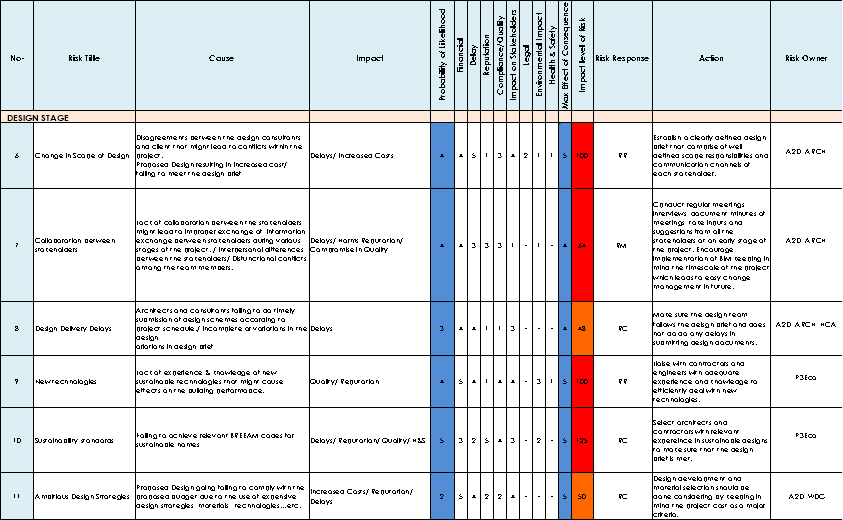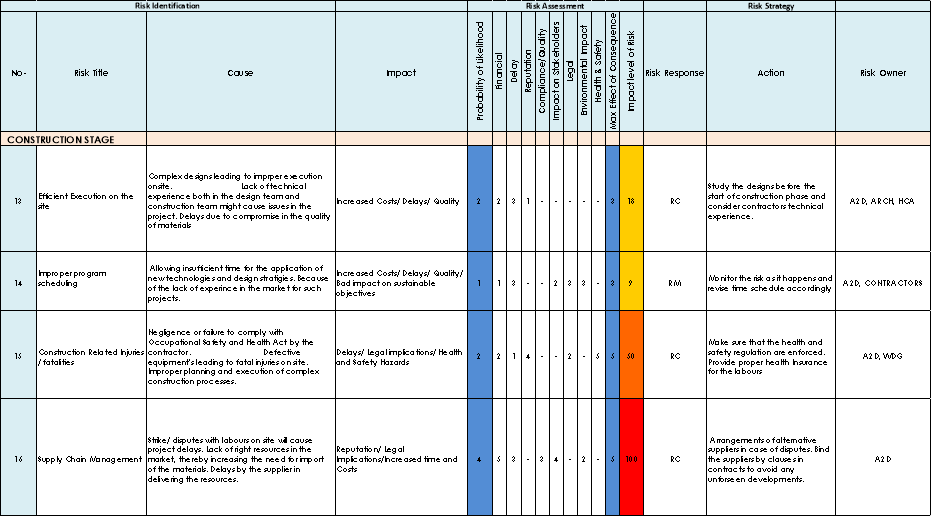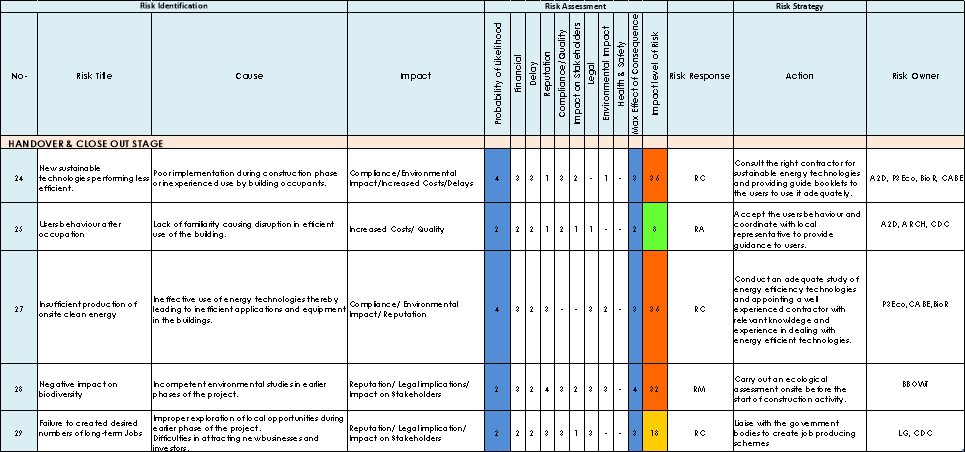Risk Assessment Strategy of Eco Town
| ✅ Paper Type: Free Essay | ✅ Subject: Construction |
| ✅ Wordcount: 2208 words | ✅ Published: 02 Aug 2018 |
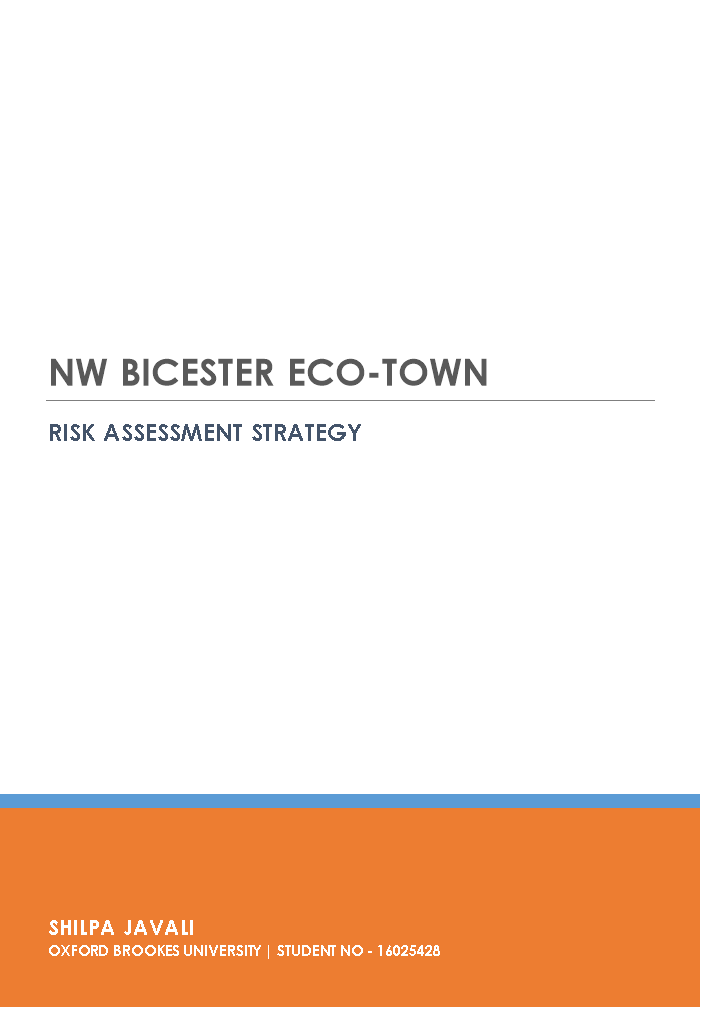
Contents (Jump to)
2. Stakeholders Objectives and Concerns
Primary Stakeholders
Secondary Stakeholders
- Defining the Boundary for Assessment
- Assessment Approach
- Stakeholders Involved
- Risk Identification and Classification Rules
- Classification of Risks
- Rating of Risk Events
1. Introduction
This report aims at developing a risk assessment strategy for NW Bicester Eco Town. Potential risks and necessary control measures will be analysed for a practical outcome. The risk assessment will also be done for the newly acquired land parcel that is adjacent to first phase which is the ‘The Exemplar’ phase of the project. Figure 1 shows the proposed site for the project.






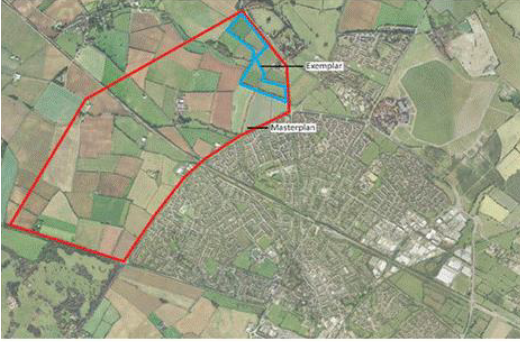
Figure 1 – Masterplan and Exemplar Phase of Bicester Eco-Town
All the stakeholders of the project and their concerns are identified to do a thorough risk assessment. These concerns are further analysed and prioritised to figure out critical success factors of the project. Based on the number of risks identified, scope and boundaries are established to streamline the risks. Further to this, risks are ranked based on the level of severity using qualitative and quantitative aspects.
2. Objectives and Concerns of Stakeholders
Eco-Town project has various stakeholders given the context of the scale, nature and typology of the project. Table 1 lists the primary stakeholders and their concerns. Table 2 lists the secondary stakeholders and their concerns
|
No. |
Primary Stakeholders |
Concerns |
|
1 |
Cherwell District Council (Local Planning Authority) |
|
|
2 |
A2Dominion (Lead Developer) |
|
Table 1 – Primary Stakeholders
|
No. |
Secondary Stakeholders |
Concerns |
|
1 |
P3 Eco Group |
|
|
2 |
Bicester Vision (BV) |
|
|
3 |
CABE – Design Consultants |
|
|
4 |
Bio-Regional (BioR) |
|
|
5 |
Grassroots Bicester (GRB) |
|
|
6 |
Farrell & Partners (ARCH) |
|
|
7 |
Thames Water Utilities (TWU) |
|
|
8 |
Central Government (CG) |
|
|
11 |
Current Residents (CLR) |
|
|
12 |
Home & Community Agency (HCA) |
|
Table 2 – Secondary Stakeholders
3. Critical Success Factors
The critical success factors are derived from the vision stated in Masterplan Vision for the Exemplar phase of the entire development are as follows:
- Provide affordable, attractive and sustainable housing – 393 residences designed by specialist design team by achieving good aesthetics within 60 acres of land use and a provision for 30% affordable housing, 40% of the total land to be used as green belt. Ensure every building achieves zero-carbon emission. Reduce carbon footprint by 30% by reducing waste sent to landfill.
- Efficient time, cost and quality management of construction – Use passive energy generating technologies and achiever zero carbon efficiency. Manage project efficiently within the budget and proposed completion time of phase 1 by circa 2018.
- Reduce Carbon footprint by adopting sustainable means of transportation and energy – Promote lean construction management which substantially reduces the carbon footprint caused by construction activities. Opt for public modes of transportation. Encourage the community to cycle. Reduce the usage of personal automotive vehicles. Introduce advanced construction technology like photo-voltaic panels, passive heating methods etc., to reduce utility bills.
- Environmental Biodiversity – Ensure that 40% of the total development area is used as green belt/ green space. Contribute to existing biodiversity by introducing waterbodies, vegetation etc.,
- Community and Neighbourhood Services – Conduct events to enhance community spirit. Provide institutional facilities like schools and community facilities like local store, sports complex etc., within the proximity of the development.
- Create New Employment Opportunities – The Exemplar phase aims at creating employment opportunities during construction phase and create long-term job opportunities.
- Managed Risk – Act as early as possible and provide visibility of a task
4. Risk Assessment Strategy
The following section provides a structured and coherent approach to identify, assess and manage risk.
Defining the Boundary for Assessment
Defining boundaries in the project helps in streamlining the risk assessment process. It is understood that risks that occur beyond the scope of the project are not under the control of Project Manager. The risk assessment is being done for the newly acquired land parcel adjacent to the boundary of the exemplar phase (See Figure 2) and the register will examine potential risks, causes, risk mitigation actions and the stakeholders responsible.

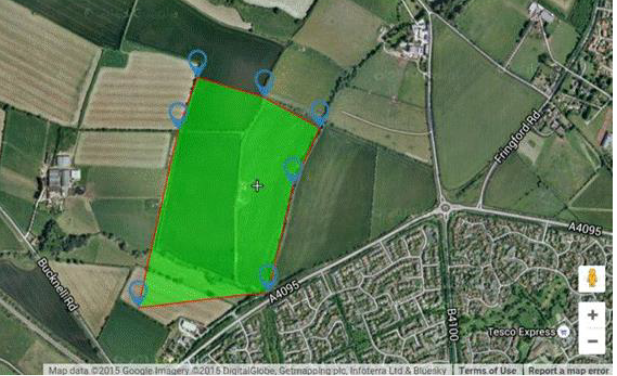
Figure 2 – Site Boundary in the Process of Acquisition
Assessment Approach
Potential risks have been identified based on the available literature on Bicester Eco-town and by brainstorming over various driving factors, likelihood of their occurrence and impact, evaluating and prioritizing risks for further action and then by developing a mitigation plan to tackle the risks without affecting the project. Figure 3 outlines the fundamental risk management process steps.
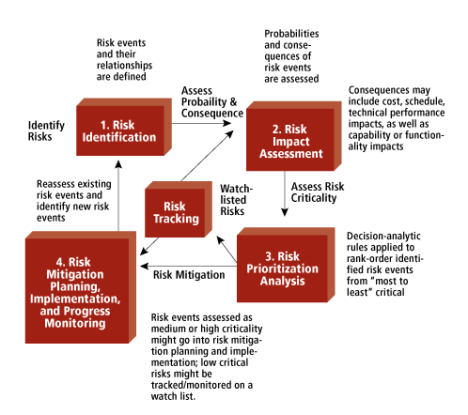
Figure 3 – Fundamental Risk Management Steps (Garvey, 2008)
Step 1. Risk Identification
Risk identification is the critical first step of the risk management process. Its objective is the early and continuous identification of risks, including those within and external to the project.
Step 2. Risk Impact and Consequence Assessment
In this step, assessment is made of the impact each risk event could have on the project. This typically includes how the event could impact cost, schedule or any other technical performance. Additional criteria such as political or economic consequences would also require consideration.
Step 3. Risk Prioritisation
In this step, overall set of identified risks, their impact and their probability of occurrence are processed to derive the most critical to least critical rank-order of all the risks. One of the main reasons for prioritizing risks is to form a basis for allocation critical resources.
Step 4. Risk Mitigating Planning
This step involves the development of mitigation plans to eliminate, reduce or manage risk. Once a plan is incorporated, it is monitored to assess its efficacy with an intention to revise its course-of-action if necessary.
The other steps involved in developing effective risk management strategy to establish a good approach to assessment and select the suitable risk management tool. In-order to do this the, various phases of the project are divided per RIBA Plan of works (RIBA,2013) and the stages are mentioned below.
- Planning
- Design
- Construction
- Handover and Close Out
Risk Identification and Classification Rules
Methodical Approach to identify risks are as follows,
- Clear classification of aims and objectives of the project.
- Develop a very good criterion for risk assessment.
- Identify risks for both aims and objectives that are derived from risk assessment criteria.
- Use both Qualitative and Quantitative measures to assess risks and rank them per their severity of impact on the project.
- Group Meetings that involve all the stakeholders and brainstorming of potential risks.
- Generate minutes of meetings (MOM) to document discussions and the responsible parties for the identified risks.
Classification of Risks
The identified risks are classified into various categories and are measured per the level of impact. The factors contributing to the measure of impact are mentioned below,
- Cost
- Time
- Reputation
- Quality
- Impact on Stakeholders
- Environmental Impact
- Legal Impact
- Health and Safety Concerns
- Legal Implications
Each of the above-mentioned factors are ranked between 1-5, 1 being the lowest and 5 being the highest in terms of impact and is detailed in Table 3.

Table 3 – Measure of Consequences of the identified Risks
Rating of Risk Events
The scoring of risks was calculated in such a way that the highest possible risk rating for any of the categories was taken into cautious consideration. The score ranging between 1 and 125, were used to generated 4 coloured rating. Here red, yellow, amber and green colours are used. The colour is assigned to a risk depending on its severity. Red stands for immediate action risk, Amber for medium risk, yellow for minor attention requiring risk and green for low/ Acceptable risk. The table 4 below illustrates the scores of this coloured rating.

Table 4 – Risk Rating Matrix
5. Risk Mitigation Plans
After identifying the risks that are very likely to occur based on the risk rating matrix, some of the risks are prioritised and a mitigation plan is proposed in the following passages below.
Risk 1: Rejection/ Delay of planning permission
Management Action Planned: Proposed development plans should comply with building regulations, standards and specifications. Consistent liaison with the government should be done.
Action Owner: A2Dominion, Architects and CABE
Cause: Development standards do not meet specified building regulations. Community objection due to improper information by the project owner.
Impact: Project delays and cost implications.
Risk 2: Community Objection
Management Action Planned: Liaise with the council members and clarify the value for public money of the development.
Action Owner: A2Dominion
Cause: Local communities showing concerns towards the effects on environment and showing reluctance to adapt to change. Lack of information or negative publicity that might lead to rejection of the development by the community.
Impact: Delays and increased cost, bad reputation of the project and negative impact on stakeholders who represent public.
Risk 3: Financial Funding Delays
Management Action Planned: Ensure funding from all the investors during the exemplar phase
Action Owner: A2Dominion and CDC
Cause: Unfamiliarity of the project to the investors compared to other developments might fail to attract the investors.
Impact: Project Failure, delays and reduction in quality if executed with insufficient funds.
Risk 4: Change in Scope of Design
Management Action Planned: Establish a clearly defined design brief that comprise of well-defined scope, responsibilities and communication channels of each stakeholder.
Action Owner: A2Dominion and ARCH
Cause: Disagreements between the design consultants and the client might lead to conflicts within the project. Proposed design might result in increased costs due to failure in meeting the design brief.
Impact: Project delays and increased cost.
Risk 5: New Technologies
Management Action Planned: Liaise with the contractors at the early stage of project in-order to evaluate their competency.
Action Owner: P3Eco
Cause: Lack of experience and improper knowledge of new sustainable technologies that might affect building performance.
Impact: Compromise in quality and project reputation
The remaining risks, their causes, impact and management action are covered in the Appendices.
6. Conclusion
After a, thorough assessment of risk on NW Bicester Eco-Town project, it is understood that the project is of a very complex nature and requires close monitoring of several areas for the successful completion of the exemplar phase. It is evident from the risk register that most of the responsibility should be taken by the developer (A2Dominion) who can further transfer risk to relevant stakeholders. Eco-Town being UK’s first project of its kind, achieving success in this project is of utmost importance in-order to set a benchmark for future developments that will be sustainable and environment friendly thereby benefitting the future generations.
References
A2Dominion., https://www.a2dominion.co.uk [Accessed on 21/12//2016]
Bicester Vision., What is Bicester Vision, http://www.bicestervision.co.uk/ [Accessed on 21/12/2016]
Cherwell District Council., Eco Bicester, http://www.cherwell.gov.uk/index.cfm?articleid=4513 [Accessed on 21/12/2016]
Design Council., Case Study – North West Bicester Eco-Town, http://www.designcouncil.org.uk/resources/case-study/north-west-bicester-eco-town [Accessed on 21/12//2016
Eco Bicester., North West Bicester, http://www.ecobicester.org.uk/cms/node/3#.WFkL0PmLRPZ [Accessed on 21/12/2016]
Garvey P (2008) Analytical Methods for Risk Management: A Systems Engineering Perspective (1st Ed.). London, New York: Chapman-Hall/ CRC
North West Bicester., Partners, http://nwbicester.co.uk/the-first-phase/introducing-exemplar/partners/ [Accessed on 21/12/2016]
North West Bicester., The first Phase – Exemplar, http://nwbicester.co.uk/masterplan/ [Accessed on 21/12/2016]
P3Eco., Home http://www.p3group.co.uk/ [Accessed on 21/12/2016]
RIBA, (2013), RIBA Plan of Work 2013 Overview, https://www.ribaplanofwork.com/PlanOfWork.aspx [Accessed on 21/12/2016]
Cite This Work
To export a reference to this article please select a referencing stye below:
Related Services
View allDMCA / Removal Request
If you are the original writer of this essay and no longer wish to have your work published on UKEssays.com then please click the following link to email our support team:
Request essay removal

